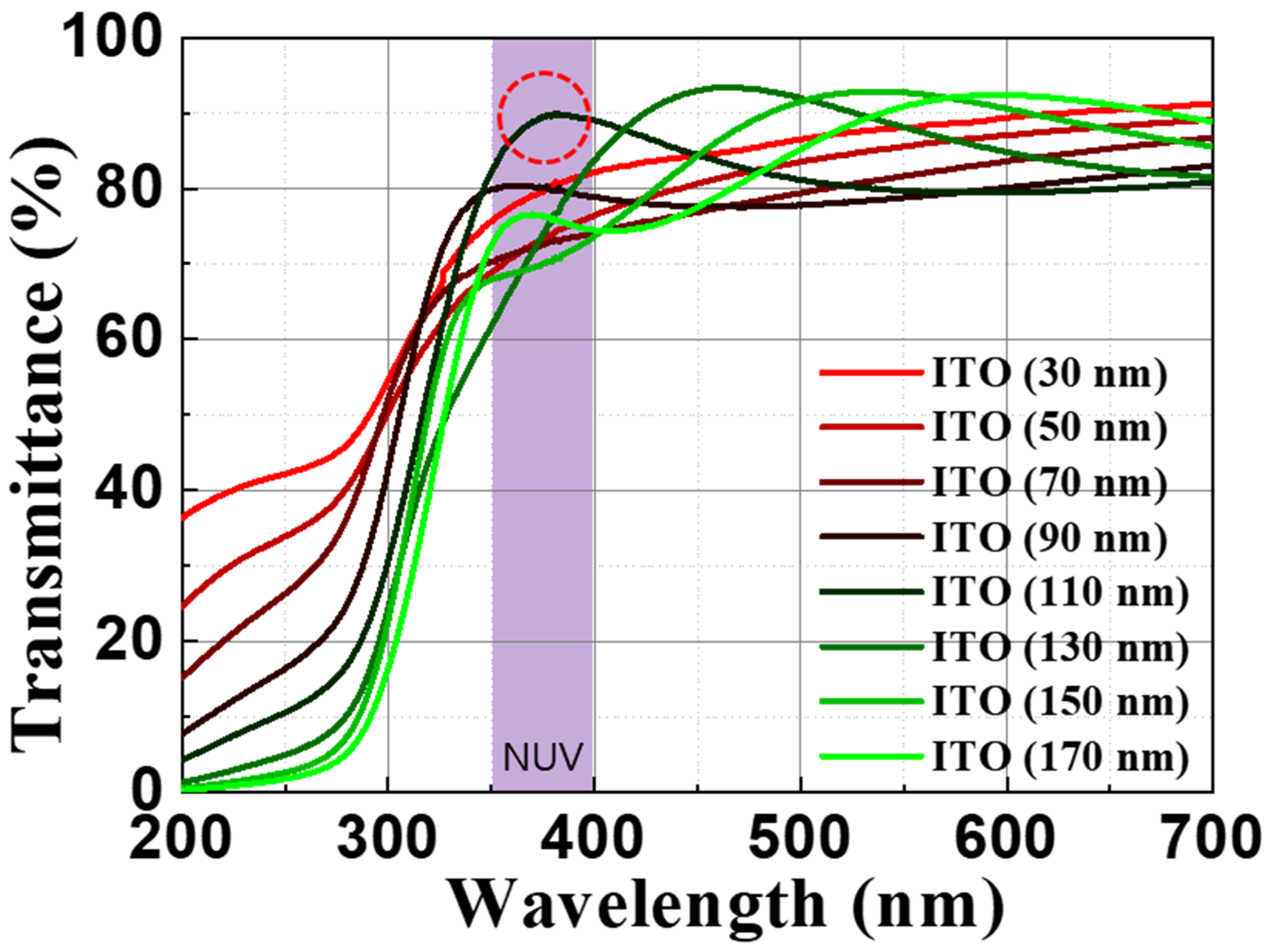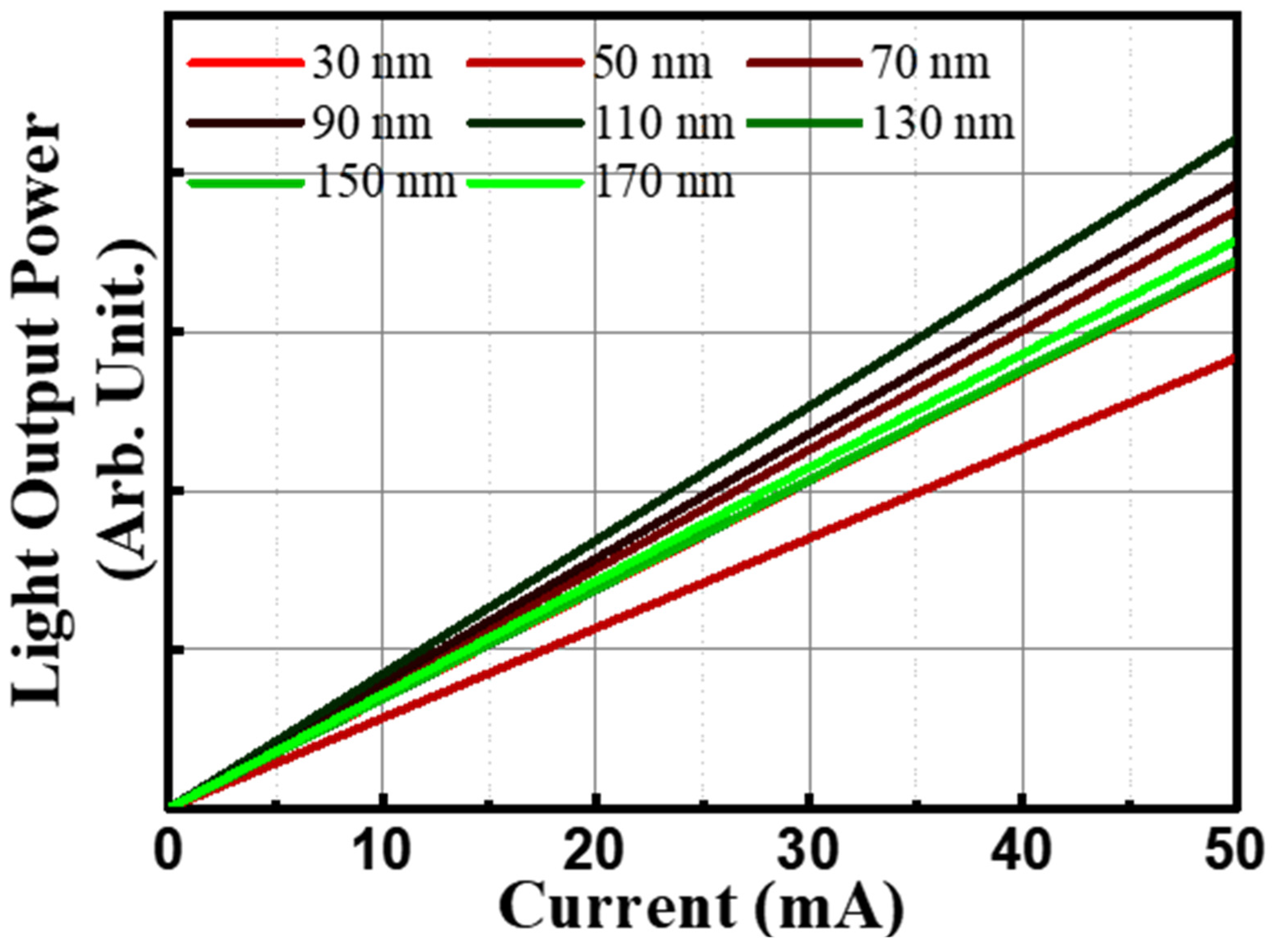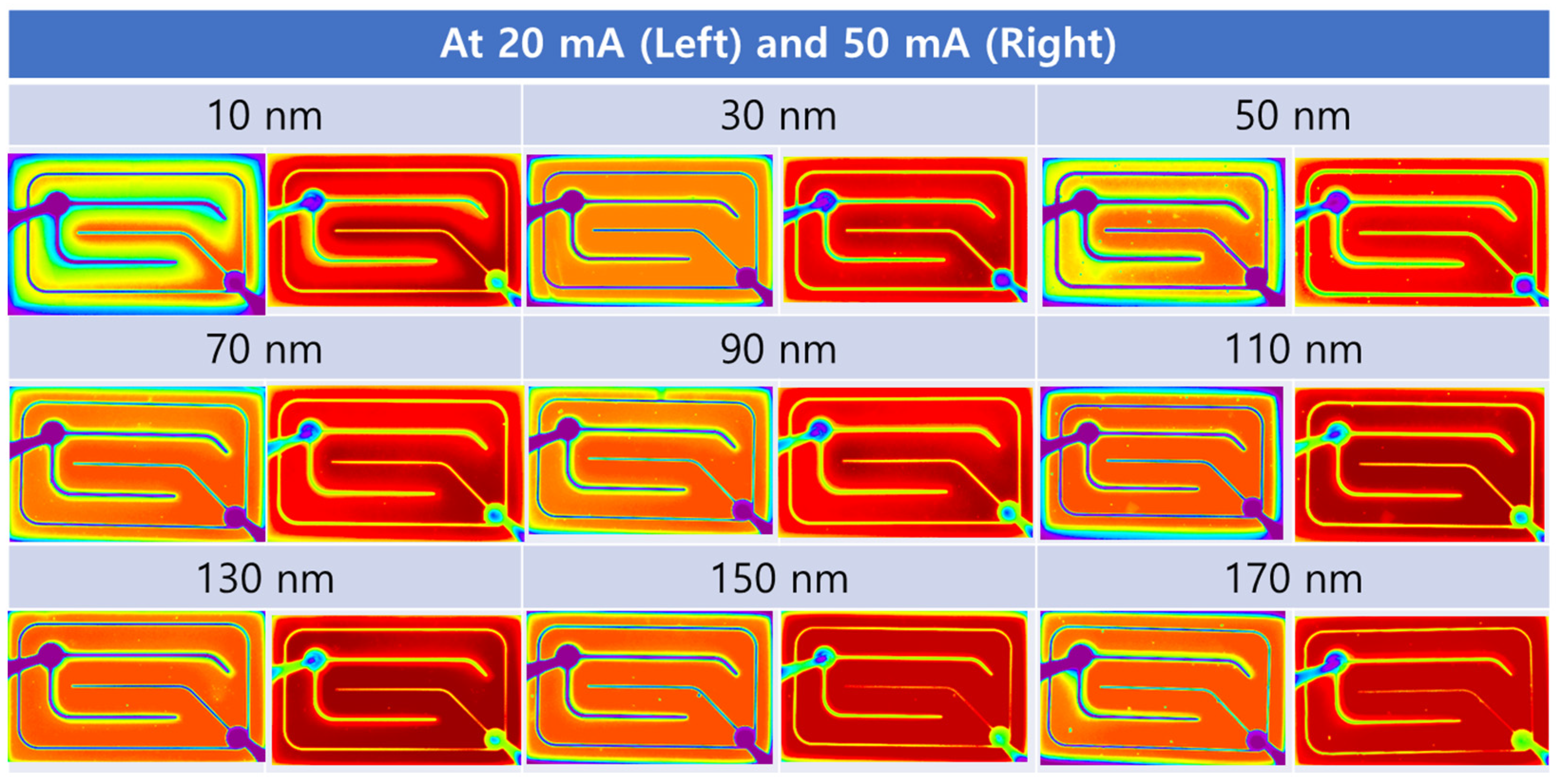A Study on Optimal Indium Tin Oxide Thickness as Transparent Conductive Electrodes for Near-Ultraviolet Light-Emitting Diodes
Abstract
:1. Introduction
2. Materials and Methods
3. Results and Discussion
4. Conclusions
Funding
Institutional Review Board Statement
Informed Consent Statement
Data Availability Statement
Conflicts of Interest
References
- Li, J.; Liu, Z.; Liu, Z.; Yan, J.; Wei, T.; Yi, Y.; Wang, J. Advances and prospects in nitrides based light-emitting-diodes. J. Semicond. 2016, 37, 061001. [Google Scholar]
- Azani, M.R.; Hassanpour, A.; Torres, T. Benefits, problems, and solutions of silver nanowire transparent conductive electrodes in indium tin oxide (ITO)-free flexible solar cells. Adv. Energy Mater. 2020, 10, 2002536. [Google Scholar] [CrossRef]
- Huseynova, G.; Lee, J.H.; Kim, Y.H.; Lee, J. Transparent Organic Light-Emitting Diodes: Advances, Prospects, and Challenges. Adv. Opt. Mater. 2021, 9, 2002040. [Google Scholar] [CrossRef]
- Chopra, K.; Major, S.; Pandya, D. Transparent conductors—A status review. Thin Solid Film 1983, 102, 1–46. [Google Scholar] [CrossRef]
- Mondal, R.K.; Adhikari, S.; Chatterjee, V.; Pal, S. Recent advances and challenges in AlGaN-based ultra-violet light emitting diode technologies. Mater. Res. Bull. 2021, 140, 111258. [Google Scholar] [CrossRef]
- Cao, B.; Li, S.; Hu, R.; Zhou, S.; Sun, Y.; Gan, Z.; Liu, S. Effects of current crowding on light extraction efficiency of conventional GaN-based light-emitting diodes. Opt. Express 2013, 21, 25381–25388. [Google Scholar] [CrossRef] [PubMed]
- Park, J.-S.; Kim, J.K.; Cho, J.; Seong, T.-Y. Group III-nitride-based ultraviolet light-emitting diodes: Ways of increasing external quantum efficiency. ECS J. Solid State Sci. Technol. 2017, 6, Q42. [Google Scholar] [CrossRef]
- Kneissl, M.; Kolbe, T.; Chua, C.; Kueller, V.; Lobo, N.; Stellmach, J.; Knauer, A.; Rodriguez, H.; Einfeldt, S.; Yang, Z. Advances in group III-nitride-based deep UV light-emitting diode technology. Semicond. Sci. Technol. 2010, 26, 014036. [Google Scholar] [CrossRef]
- Park, T.-Y.; Choi, Y.-S.; Kang, J.-W.; Jeong, J.-H.; Park, S.-J.; Jeon, D.M.; Kim, J.W.; Kim, Y.C. Enhanced optical power and low forward voltage of GaN-based light-emitting diodes with Ga-doped ZnO transparent conducting layer. Appl. Phys. Lett. 2010, 96, 051124. [Google Scholar] [CrossRef] [Green Version]
- Cho, C.-Y.; Choe, M.; Lee, S.-J.; Hong, S.-H.; Lee, T.; Lim, W.; Kim, S.-T.; Park, S.-J. Near-ultraviolet light-emitting diodes with transparent conducting layer of gold-doped multi-layer graphene. J. Appl. Phys. 2013, 113, 113102. [Google Scholar] [CrossRef] [Green Version]
- Lee, J.H.; Woo, K.Y.; Kim, K.H.; Kim, H.-D.; Kim, T.G. ITO/Ag/ITO multilayer-based transparent conductive electrodes for ultraviolet light-emitting diodes. Opt. Lett. 2013, 38, 5055–5058. [Google Scholar] [CrossRef]
- Xu, J.; Zhang, W.; Peng, M.; Dai, J.; Chen, C. Light-extraction enhancement of GaN-based 395 nm flip-chip light-emitting diodes by an Al-doped ITO transparent conductive electrode. Opt. Lett. 2018, 43, 2684–2687. [Google Scholar] [CrossRef] [PubMed]
- Almaev, A.V.; Kopyev, V.V.; Novikov, V.A.; Chikiryaka, A.V.; Yakovlev, N.N.; Usseinov, A.B.; Karipbayev, Z.T.; Akilbekov, A.T.; Koishybayeva, Z.K.; Popov, A.I. ITO Thin Films for Low-Resistance Gas Sensors. Materials 2022, 16, 342. [Google Scholar] [CrossRef] [PubMed]
- Liu, Y.; Shi, P.; Ren, W.; Huang, R. Thermoelectrical Properties of ITO/Pt, In2O3/Pt and ITO/In2O3 Thermocouples Prepared with Magnetron Sputtering. Crystals 2023, 13, 533. [Google Scholar] [CrossRef]
- Sheremet, V.; Genç, M.; Elçi, M.; Sheremet, N.; Aydınlı, A.; Altuntaş, I.; Ding, K.; Avrutin, V.; Özgür, Ü.; Morkoç, H. The role of ITO resistivity on current spreading and leakage in InGaN/GaN light emitting diodes. Superlattices Microstruct. 2017, 111, 1177–1194. [Google Scholar] [CrossRef] [Green Version]
- Lee, G.W.; Na, Y.C.; Lee, S.N. Self-Assembled Nanowrinkle-Network-Structured Transparent Conductive Zinc Oxide for High-Efficiency Inorganic Light-Emitting Diodes. Adv. Mater. Interfaces 2022, 9, 2101460. [Google Scholar] [CrossRef]
- Kim, Y.C.; Lee, S.J.; Myoung, J.-M. Enhanced Light Extraction from p-Si Nanowires/n-IGZO Heterojunction LED by Using Oxide–Metal–Oxide Structured Transparent Electrodes. J. Phys. Chem. C 2017, 121, 6788–6795. [Google Scholar] [CrossRef]
- Lai, C.-H.; Lee, Z.-Y.; Lin, S.-C.; Chuang, Y.-H. Al-doped ZnO transparent conducting glass with an IGZO buffer layer for dye-sensitized solar cells. IEEE J. Photovolt. 2020, 10, 795–802. [Google Scholar] [CrossRef]
- Liang, S.; Zhou, Q.; Li, X.; Zhong, M.; Wang, H. Electrical and optical properties of a transparent conductive ITO/Ga2O3/Ag/Ga2O3 multilayer for ultraviolet light-emitting diodes. Nanomaterials 2019, 9, 403. [Google Scholar] [CrossRef] [Green Version]
- Kang, C.H.; Shen, C.; M Saheed, M.S.; Mohamed, N.M.; Ng, T.K.; Ooi, B.S.; Burhanudin, Z.A. Carbon nanotube-graphene composite film as transparent conductive electrode for GaN-based light-emitting diodes. Appl. Phys. Lett. 2016, 109, 081902. [Google Scholar] [CrossRef]
- Wang, L.; Liu, W.; Zhang, Y.; Zhang, Z.-H.; Tan, S.T.; Yi, X.; Wang, G.; Sun, X.; Zhu, H.; Demir, H.V. Graphene-based transparent conductive electrodes for GaN-based light emitting diodes: Challenges and countermeasures. Nano Energy 2015, 12, 419–436. [Google Scholar] [CrossRef]
- Zhang, H.; Mischke, J.; Mertin, W.; Bacher, G. Graphene as a transparent conductive electrode in GaN-based LEDs. Materials 2022, 15, 2203. [Google Scholar] [CrossRef]
- Wang, L.; Cheng, Y.; Liu, Z.; Yi, X.; Zhu, H.; Wang, G. Hybrid tunnel junction–graphene transparent conductive electrodes for nitride lateral light emitting diodes. ACS Appl. Mater. Interfaces 2016, 8, 1176–1183. [Google Scholar] [CrossRef] [PubMed]
- Lee, H.B.; Jin, W.-Y.; Ovhal, M.M.; Kumar, N.; Kang, J.-W. Flexible transparent conducting electrodes based on metal meshes for organic optoelectronic device applications: A review. J. Mater. Chem. C 2019, 7, 1087–1110. [Google Scholar] [CrossRef]
- Nitta, A.; Chosa, N.; Takeda, K. Effect of Surfactant Addition on Organic Transparent Conductive Films Fabricated by Inkjet Printing Method. Electron. Mater. 2021, 2, 536–544. [Google Scholar] [CrossRef]
- Zhang, C.; Anasori, B.; Seral-Ascaso, A.; Park, S.H.; McEvoy, N.; Shmeliov, A.; Duesberg, G.S.; Coleman, J.N.; Gogotsi, Y.; Nicolosi, V. Transparent, flexible, and conductive 2D titanium carbide (MXene) films with high volumetric capacitance. Adv. Mater. 2017, 29, 1702678. [Google Scholar] [CrossRef]
- Kumar, A.; Shaikh, M.O.; Chuang, C.-H. Silver nanowire synthesis and strategies for fabricating transparent conducting electrodes. Nanomaterials 2021, 11, 693. [Google Scholar] [CrossRef]
- Miao, J.; Fan, T. Flexible and stretchable transparent conductive graphene-based electrodes for emerging wearable electronics. Carbon 2023, 202, 495–527. [Google Scholar] [CrossRef]
- Jeong, G.-J.; Lee, J.-H.; Han, S.-H.; Jin, W.-Y.; Kang, J.-W.; Lee, S.-N. Silver nanowires for transparent conductive electrode to GaN-based light-emitting diodes. Appl. Phys. Lett. 2015, 106, 031118. [Google Scholar] [CrossRef]
- Kim, J.-Y.; Oh, G.-G.; Kim, E.; Kim, H.-S.; Hong, G.; Ryou, J.-H.; Kwon, M.-K. Silver-Nanowire-Based Localized-Surface-Plasmon-Assisted Transparent Conducting Electrode for High-Efficiency Light-Emitting Diode. Appl. Sci. 2021, 11, 7747. [Google Scholar] [CrossRef]
- Min, J.-H.; Kwak, H.-M.; Kim, K.; Jeong, W.-L.; Lee, D.-S. Very thin ITO/metal mesh hybrid films for a high-performance transparent conductive layer in GaN-based light-emitting diodes. Nanotechnology 2016, 28, 045201. [Google Scholar] [CrossRef]
- Lin, Y.-C.; Chang, S.-J.; Su, Y.-K.; Tsai, T.-Y.; Chang, C.; Shei, S.-C.; Kuo, C.; Chen, S. InGaN/GaN light emitting diodes with Ni/Au, Ni/ITO and ITO p-type contacts. Solid-State Electron. 2003, 47, 849–853. [Google Scholar] [CrossRef]
- Margalith, T.; Buchinsky, O.; Cohen, D.; Abare, A.; Hansen, M.; DenBaars, S.; Coldren, L. Indium tin oxide contacts to gallium nitride optoelectronic devices. Appl. Phys. Lett. 1999, 74, 3930–3932. [Google Scholar] [CrossRef]
- Qiao, Z.; Latz, R.; Mergel, D. Thickness dependence of In2O3: Sn film growth. Thin Solid Film 2004, 466, 250–258. [Google Scholar] [CrossRef]
- Guittoum, A.; Kerkache, L.; Layadi, A. Effect of thickness on the physical properties of ITO thin films. Eur. Phys. J.-Appl. Phys. 1999, 7, 201–206. [Google Scholar] [CrossRef]
- Mulato, M.; Chambouleyron, I.; Birgin, E.; Martınez, J. Determination of thickness and optical constants of amorphous silicon films from transmittance data. Appl. Phys. Lett. 2000, 77, 2133–2135. [Google Scholar] [CrossRef] [Green Version]
- Kim, H.; Horwitz, J.; Kushto, G.; Pique, A.; Kafafi, Z.; Gilmore, C.; Chrisey, D. Effect of film thickness on the properties of indium tin oxide thin films. J. Appl. Phys. 2000, 88, 6021–6025. [Google Scholar] [CrossRef]
- Heavens, O.S. Optical Properties of Thin Solid Films; Courier Corporation: North Chelmsford, MA, USA, 1991. [Google Scholar]
- Haacke, G.; Ando, H.; Mealmaker, W. Spray deposition of cadmium stannate films. J. Electrochem. Soc. 1977, 124, 1923. [Google Scholar] [CrossRef]






| ITO Thickness | Rsheet (Ω/□) | Transmittance (%) | Figure of Merit |
|---|---|---|---|
| 30 nm | 253 (±19) | 80.9 | 4.8 × 10−4 |
| 50 nm | 157 (±13) | 74.8 | 3.5 × 10−4 |
| 70 nm | 151 (±11) | 73.2 | 2.9 × 10−4 |
| 90 nm | 140 (±13) | 79.6 | 7.2 × 10−4 |
| 110 nm | 131 (±12) | 89.7 | 2.5 × 10−3 |
| 130 nm | 90 (±10) | 78.4 | 9.7 × 10−4 |
| 150 nm | 79 (±8) | 71.3 | 4.3 × 10−4 |
| 170 nm | 50 (±4) | 75.5 | 1.2 × 10−3 |
| ITO Thickness | Light Output Power (A.U.) | Electroluminescence Intensity (A.U.) | Peak Wavelength (nm) |
|---|---|---|---|
| 30 nm | 0.81 | 0.84 | 385.3 |
| 50 nm | 0.67 | 0.71 | 385.7 |
| 70 nm | 0.89 | 0.83 | 386.4 |
| 90 nm | 0.93 | 0.89 | 386.1 |
| 110 nm | 1.00 | 1.00 | 386.8 |
| 130 nm | 0.82 | 0.7 | 386.8 |
| 150 nm | 0.82 | 0.75 | 386.4 |
| 170 nm | 0.85 | 0.91 | 385.7 |
Disclaimer/Publisher’s Note: The statements, opinions and data contained in all publications are solely those of the individual author(s) and contributor(s) and not of MDPI and/or the editor(s). MDPI and/or the editor(s) disclaim responsibility for any injury to people or property resulting from any ideas, methods, instructions or products referred to in the content. |
© 2023 by the author. Licensee MDPI, Basel, Switzerland. This article is an open access article distributed under the terms and conditions of the Creative Commons Attribution (CC BY) license (https://creativecommons.org/licenses/by/4.0/).
Share and Cite
Kim, M.-J. A Study on Optimal Indium Tin Oxide Thickness as Transparent Conductive Electrodes for Near-Ultraviolet Light-Emitting Diodes. Materials 2023, 16, 4718. https://doi.org/10.3390/ma16134718
Kim M-J. A Study on Optimal Indium Tin Oxide Thickness as Transparent Conductive Electrodes for Near-Ultraviolet Light-Emitting Diodes. Materials. 2023; 16(13):4718. https://doi.org/10.3390/ma16134718
Chicago/Turabian StyleKim, Min-Ju. 2023. "A Study on Optimal Indium Tin Oxide Thickness as Transparent Conductive Electrodes for Near-Ultraviolet Light-Emitting Diodes" Materials 16, no. 13: 4718. https://doi.org/10.3390/ma16134718






